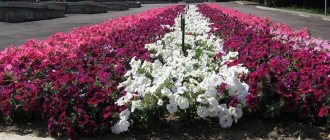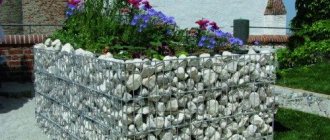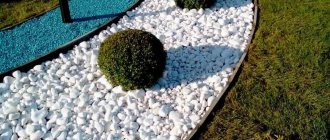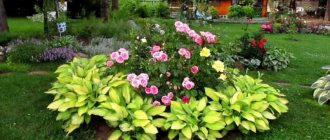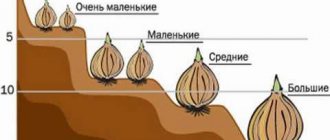Techniques for creating a flower bed that blooms all summer
A flowerbed that assumes continuous flowering throughout the entire gardening season from spring to autumn will never look equally impressive throughout this time.
It is much better to create a flower bed that looks as luxurious as possible in one season, for example in summer. And then extend the flowering season for this flowerbed by adding earlier or later flowering plants. This will give you a beautiful flowerbed that will bloom from April to October, with a peak in June-August.
Flower beds that bloom all summer often contain peonies, roses, dahlias, and phlox. If you choose them in one tone, for example, pink, then for spring you can add lavender tulips and hyacinths to this flowerbed, and use pink perennial asters for autumn flowering.
An attractive appearance of the flowerbed from March to May can be created by the foliage of such perennials as hydrangea and boodleea, which will bloom only at the end of summer - this will allow these flowers to be used in the overall composition of the flowerbed for two seasons. This will be especially impressive if you add unpretentious garden ferns to them.

For late flowering of a flower bed, you can add unpretentious annuals to its composition, such as cosmos, salvia, zinnia - they will bloom until late autumn. This way your flowerbed will be bright and beautiful from mid-April to mid-October.
And if you add decorative grasses to the flowerbed, the flowerbed will retain its attractiveness until the first frost.

Flowerbed of perennial flowers
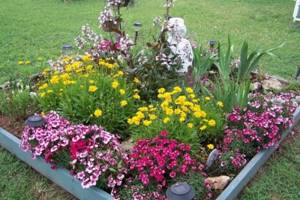
Perennial flowers easily tolerate winter frosts and do not need to be planted every spring.
There are a huge number of species of perennials, from the assortment of which you can choose to implement the idea of a flower garden, at the same time make it original, and admire the flowers from spring until late autumn.
The advantages of perennial plants are:
- No need for annual planting;
- Resistance to winter frosts;
- Easy to care for;
- Easy to grow, when transplanting you can simply divide it and thus propagate
- All summer they either bloom or delight with green foliage on the stems.
There are several ways to plant perennial flowers:
- Seeds;
- Roots;
- Bulbs.
When planting seeds in the ground, it is better to immediately create compositions that will not need to be replanted for 2-3 years.
There are some rules for planting perennials:
- Drawing up a flowerbed diagram;
- Planting low-growing flowers in the foreground;
- Climbing plants are planted along the alleys;
- It is necessary to take into account the shades of flowers, during the flowering of plants, everything should be in harmony.
Perennial flowering plants are divided according to growth into 4 groups:
- Short stature;
- Medium height;
- Tall;
- Curly.
Flowers that grow no higher than 30 cm are considered low-growing. The most popular of them are:
- Pansies delight the eye with their colorful flowers that bloom throughout the summer;
- Periwinkle grows on any soil, tolerates frosts well, most often it is planted to decorate stone compositions, after a while it grows into a green carpet with blue or pink drops;
- Phloxes have many shades of color, grow well in moist soil, no more than 7 plants are planted per square meter;
- Gentian, which looks like blue or pale blue bells, blooms from June to September.
Medium-sized flowers up to 1 meter high. Most often the following are planted in the flowerbed:
- Daylily can grow without transplanting in one place for more than 10 years, because it is not picky about the soil, has more than 25 species, blooms from the beginning of June with a large number of flowers;
- Rhodiola, pink Rhodiola is popular, but you can often see yellow Rhodiola in flower beds; it blooms in the first two summer months.
Among the flowers from the tall group, the following are planted more preferably than others:
- Sunflowers look great both separately from other plants and in combination with them; they bloom in the second half of summer;
- Stock roses, a most beautiful plant growing up to one and a half meters, bloom brightly, and are packed like a peony, blooming all summer and a little in September.
Among the climbing flowers, the most in demand are:
- The climbing rose is a hybrid that was obtained after crossing a garden rose with a wild variety, the flowers are small with a delicate aroma, they require abundant watering and sunlight, it is better to insulate the roots for the winter;
- Wisteria, similar to a deciduous vine that twines around a support, flowers resemble bunches of grapes, requires care, pruned twice a year;
- Maiden grape, a tree-like vine with suckers and tendrils that cling to any type of surface without any support; the foliage changes color depending on the air temperature;
- Honeysuckle is a perennial shrub up to 3 meters tall, requires staking and constant pruning, the inflorescences emit a unique aroma, are easy to care for, and grow on any soil.
Perennial flowers have many types, varieties, with a variety of colors, names and shapes. For a flower bed, each owner determines for himself what he wants to see from the flowers during warm days.
How to choose a place for a flower bed of continuous flowering
Choosing a location for a flower bed can have a significant impact on our choice of flowers and the overall design of the flower bed. Based on the location, we will plan the peak flowering season and select the plants that will form the basis of our flowerbed. Then we expand the flowering time of the planned flower bed, adding to it some flowers with an earlier and later flowering period.

If you have a shady garden, the most suitable for such a flower bed will be flowers that bloom in spring and early summer.
If you have a sunny garden, then most flowers will feel comfortable in such a flowerbed. This arrangement is ideal for a flower bed that will bloom all summer.
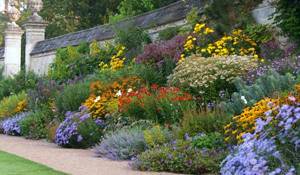
If you are planning to place a flower bed in the southwest, you have a wonderful location for a flower bed that peaks in fall. Because It is this arrangement of the flowerbed that will allow it to receive the greatest amount of light during the shorter autumn days.
Flowers to bloom all summer
What flowers to plant so that the flower bed blooms all summer
To grow the most suitable plants, you need to take into account that, from the point of view of landscape design, perennial flowers for flower beds can be divided into three main types:
- low growing plants;
- those that are of average size;
- tall.
Now about growing plants of these categories in more detail.
Low-growing perennials are very common.
Among them it is worth mentioning those that can be planted in a flower garden:
- dwarf asters;
- soapworts;
- phlox;
- aquilegia;
- aubriet;
- gentians.
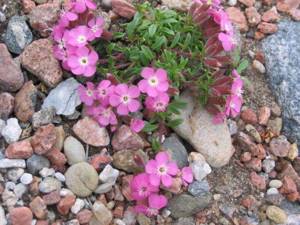
Soapworts are low-growing perennials
This category includes those whose height does not exceed 30 cm.
Those of medium size are those whose height ranges from 30 to 80 cm.
An example of medium-sized unpretentious flowers could be:
- day-lily;
- yarrow;
- peonies;
- roses;
- pink radios.
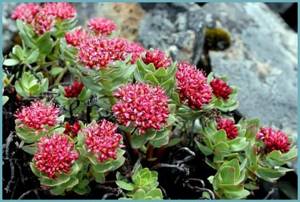
Pink radios
Tall plants are those whose height is more than 80 cm. It is believed that it is also necessary to plant such flowers.
You can mention the names of the colors:
- mallow;
- basilisks;
- window sills;
- tortuous sunflowers;
- stock roses.
Here are the flowers to plant in your flowerbed to bloom all summer:
- Crocuses, daisies, daffodils, tulips, pansies and primroses bloom in early spring. The flowering period is a month. At the beginning of May, lupins, peonies, aquilegias, as well as late varieties of tulips begin to bloom. By the end of May, hyacinths and imperial hazel grouse are in bloom.
- Many varieties bloom in summer. Among them are roses, hydrangeas, gillyflowers, amaranths, hibiscus, delphiniums, liatris, rudbeckia, achinacea and other flowers. If you take good care of them, you can not only enjoy their appearance, but also inhale wonderful floral aromas.
- When autumn arrives, ageratum, carnations, begonias or remontant roses should bloom. It is a good choice to complement them with flowers such as asters, salvia, coreopsis, helenium or sedum.
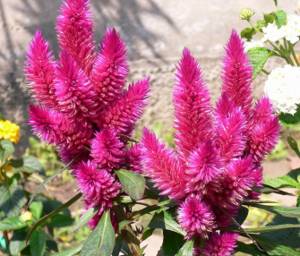
Amaranths bloom all summer
What flowers to plant in a flowerbed to bloom from spring to autumn
Perennials for spring and early summer
These are some of the best spring-blooming perennials, best suited for a shady area to create a beautiful perennial bed:
Tulips • Snowdrops • Muscari • Hyacinths • Irises • Daffodils • Crocuses • Primrose • Periwinkle
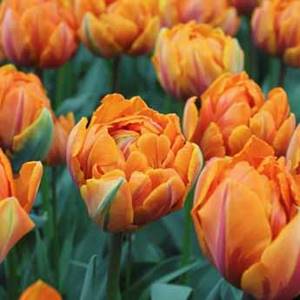
Tulips
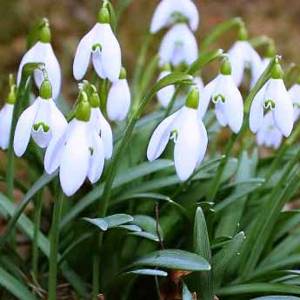
Snowdrops

Muscari
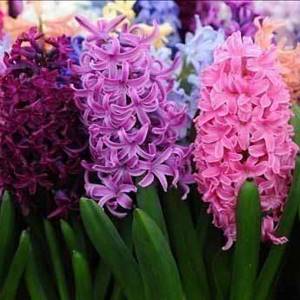
Hyacinths
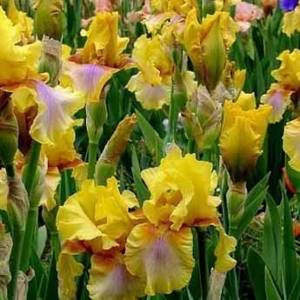
Irises
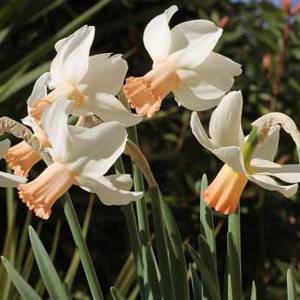
Daffodils

Crocuses
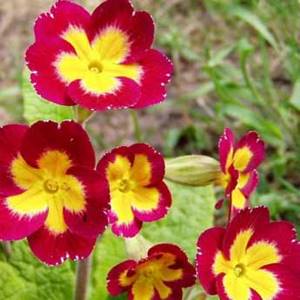
Primrose
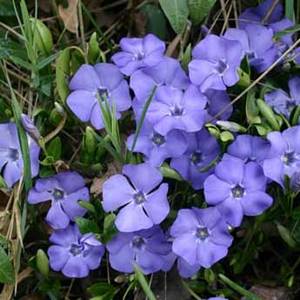
Periwinkle
Summer flowering perennials
These are some of the best perennials for flower beds that bloom at their peak in the summer months:
Dahlias • Roses • Daylily • Delphinium • Speedwell • Poppies • Anemones • Astilbe • Sage
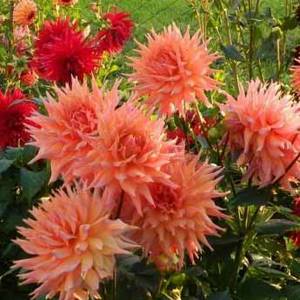
Dahlias
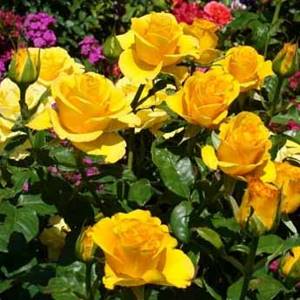
Roses
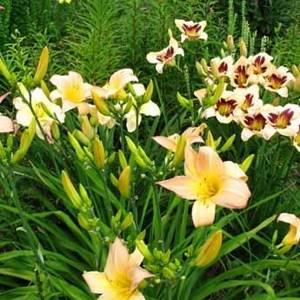
Day-lily
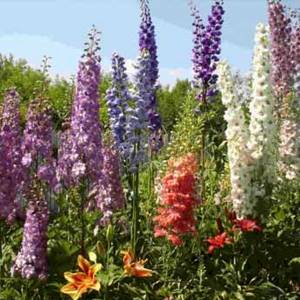
Delphinium
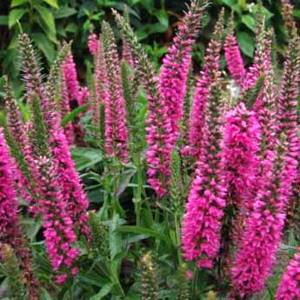
Veronica

poppies
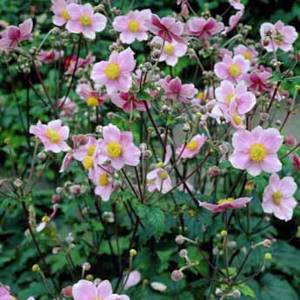
Anemone

Astilbe
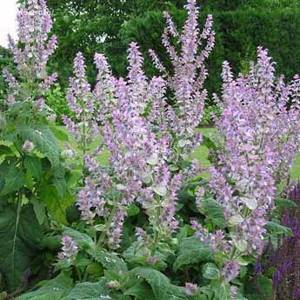
Sage
Perennials for late summer and early fall
These are some of the best fall-blooming perennials, starting to bloom in late August and continuing into the fall:
Chrysanthemums • Perennial asters • Echinacea • Helenium • Rudbeckia • Coreopsis • Goldenrod • Yarrow • Sedum
Chrysanthemums Perennial asters Echinacea Helenium Rudbeckia Coreopsis Goldenrod Yarrow Sedum
Basic moments
The question of how to create a flowerbed of continuous flowering can lead a novice gardener to a dead end, but experienced gardeners know that the secret to creating it is very simple. When creating such a flower garden and selecting plants, you only need to know exactly in what period they will bloom. By planting several varieties in one bed, which will gradually replace each other, you don’t have to worry about the plot looking untidy or empty.

Some may think this is a fairly simple job. Indeed, there is nothing easier - to plant flowers with different flowering periods and just enjoy the work done
But at this moment it is important to take into account all the nuances of such flower beds
First of all, take into account that each planting requires different care, different levels of watering, lighting, soil conditions and much, much more. Therefore, when planning a mixborder, you need to select all those varieties that have similar care requirements. Plants for a continuous flowering bed, as has already become known, are selected carefully, but even with 5-6 different types of plantings you can create an amazing and unique mixborder
The basic rule, which is important to follow both when creating small beds and large lawns, is considered to be a more or less accurate count of flowering periods. Usually it does not exceed a couple of weeks
In order to somewhat smooth out the moment of withering of some buds and the blossoming of others, you need to place some deciduous plants that are highly decorative in the garden bed.
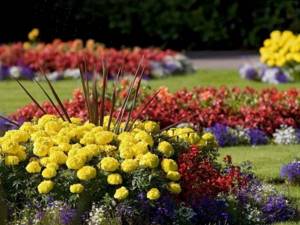
To make it easier to navigate, it is better to draw a rough plan on a sheet of paper with a mark of the types of flowers that will grow. So, if you plan to create a flower garden on a large open area of your dacha, then the diagram of a flower bed of continuous flowering perennials should look like this:
The center of the entire composition should be higher varieties of plantings. Here it is also permissible to place plants that do not bloom, but create a decorative effect. However, it is not recommended to concentrate them in one place. It is better to place them evenly in the garden bed so that they grow in bouquets of flowers. The closer to the edge, the shorter the plantings should be. At the end of the bed, you can even plant small plants creeping along the ground, which can hide the outline and add visual naturalness. When selecting different shades, be sure to maintain some compatibility between the shades
But at the same time, do not forget about bright spots that can attract attention and thus place accents, making even a simple flower bed unusual and bright.
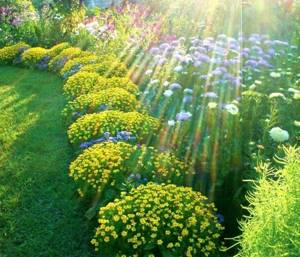
If the flower bed is to be placed near a fence or fence, then tall plants should be planted closer to it. Their length should also be reduced in accordance with how far the mixborder will extend into the area.
Planting a flower bed: how many flowers to plant
The most common mistake when creating a flower bed is to plant one copy of your favorite plant. Using a disproportionate number of different types of flowers, you may not get the result you expected - your flowerbed may look chaotic.
It is much better to limit your choice of plants for your flower bed to ten species that you like. Make sure their flowering dates coincide or complement each other.

Buy 3-5-7-9 copies of one type, depending on the size of your flower bed. Then you will create a beautiful floral carpet where your plants will transition from one to another in a smooth, natural way.
Buying several copies of the same species will not only not undermine your budget, but, on the contrary, will allow you to save money - because you will still be buying a certain number of plants to fill the entire space of the flower garden. And if you buy several identical plants, you can count on a discount on your purchase.
Blooming flower bed
There are many types of flower beds: flower beds and arabesques, borders and ridges, mixborders, alpine slides and parterres. A classic flowerbed is a composition of a geometric shape with a closed contour and with one or more types of plants. Flowerbeds are located in front of the house or entrance, on the lawn, near the fence, in the tree trunk. A flowerbed that blooms all summer will be the best decoration of the garden.

Flower beds are designed in one of the main styles - regular or landscape. A regular flowerbed has strict lines, a clear pattern, and all the plants on it bloom at the same time. Such flower beds are usually created in parks and squares. In country gardens, flower beds are usually designed in a landscape style, where there is no symmetry, no clear boundaries, and smooth lines.

There are carpet and flower beds, and by location – central and side flower beds.
There are raised, potted, vertical and even floating flower beds.
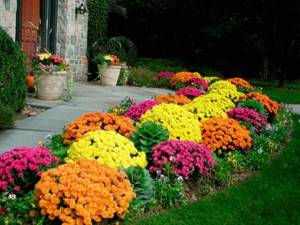
When is the best time to plant flowers in a flower bed?
If you buy potted plants, they can be planted throughout the year with two exceptions.
Never plant when the ground is icy - wait for better weather by burying your plants near a wall. A wall facing west is ideal.
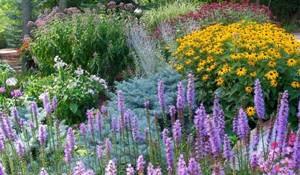
Don't plant in hot, dry conditions unless you can water regularly, because once the root ball dries out, the plant will suffer.
How to plant correctly
How to make a flowerbed without weeds
Before you design a flower garden, you need to choose where it will be grown. It is believed that in order to create a flowerbed that blooms throughout the year, you need to find a place that is well lit by the sun's rays.
On a note. Before planting, it is necessary not only to properly fertilize the soil, but also to add raising agents. For this purpose, you can use brick chips, expanded clay or sand.
To create a beautiful flower garden from perennials, using low-growing plants for this plan, it is necessary to take into account the following:
- You need to use the sunny side to place low-growing plants. If positioned differently, they will not receive sufficient sunlight. However, you should not expect that they will be able to bloom magnificently.
- When planting medium-sized plants, you need to leave a larger distance between them, compared to small plants. It is necessary to take into account that as they grow and flower, they will gradually expand, and they need to choose a place for this.
Interesting. Before you start planting flowers, you need to draw up a preliminary flower planting plan. Since the flower bed must bloom throughout the warm season, it is necessary to arrange it in such a way that during this entire period one or more types of flowers bloom at any given time.
How to prepare the soil for planting flowers in a flower bed
Land preparation has a significant impact on how our plants will look and develop in the future.
Use a hoe to remove weeds from the future planting site, carefully removing all roots. Dig up the planting area to a bayonet depth. Add compost - rotted manure, leaves, grass. Now you can plant flowers - carefully pull the flower out of the pot, straighten the roots and plant it in the flowerbed.
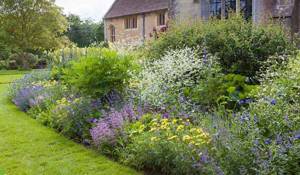
In dry weather, make sure you water your plants well the first year they are grown.
flower bed
Flower beds are decorated with flowering annuals and perennials of different heights. If the flowerbed is visible from all sides, then taller flowers are planted in the center, followed by lower plants. If the flower garden is located along a wall or fence and is visible from one side, tall plants are placed in the background. Also sometimes they make a slight slope of the soil from the fence.

Annual blooming flowers for the flower bed:
- asters;
- purslane;
- marigold;
- salvia;
- begonias;
- Iberis;
- ageratum;
- lobelia.
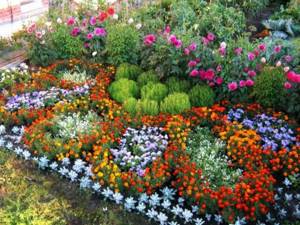
One of the simple but effective options is a round flower bed. Inside the large circle, a small one is drawn, in which taller flowers or a beautiful shrub are planted, and then several more types of plants are planted in concentric circles.

Note!

The best flowers for a flower bed: an overview of all types, unpretentious types, tips for choosing, beautiful combinations, names (150 photos)
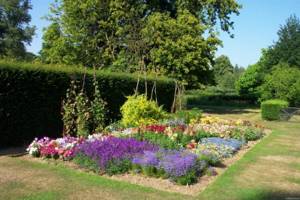
Rabatka (135 photos): organization options, flower beds of perennials and annuals, the best DIY options, examples from A to Z
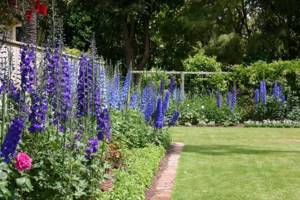
The best flowers for the garden: unpretentious and long-blooming, tips for choosing and planting, not requiring special care, flowers for the garden (125 photos)
How to design a flower bed that blooms all summer
- Once you have purchased your plants, plant them in your flower bed. Give each plant enough room for future growth, keeping in mind that larger plants will need more space.
- Do not place plants in a specific height: low ones closer, high ones further away - this way your flowerbed will look too formal, like at a parade. If you have a tall air plant, such as a cosmos, it can be planted close to the outer edge of the flower bed, it will create an intriguing light curtain.
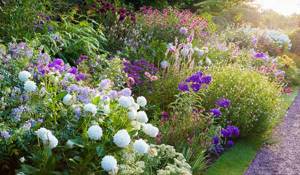
- Avoid making round flower beds, because they do not allow the gaze to slide and are not beneficial from the point of view of the general perspective of landscape design. Try to make the shape of the flower bed so that it allows the plants to extend beyond its border. This could be a wavy border or some kind of irregular triangle that protrudes from the main flower bed and then returns back to the general border. This placement of one large plant away from the main group deceives the eye and makes the flower garden visually larger.
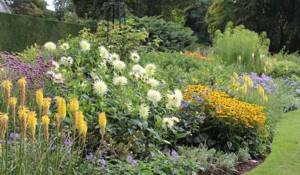
- Mix up textures by adding vertical plants. Uplifting trunks of plants such as delphiniums and lupines connect the ground to the sky and break up the monotony of many flower mounds, the natural growth pattern of most flowers, thus creating greater elegance and interest. The sword-shaped leaves of irises and gladioli have the same effect, and they are sure to add more grace to any flower bed.
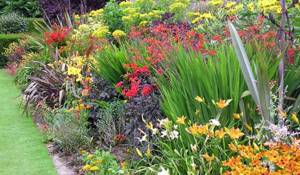
- Add one bold and tall plant. For example, amaranth or castor bean will explode a flower bed with their burgundy-red foliage, while at the same time becoming an advantageous backdrop for more neutral plants, making the flower garden much more colorful.

- If you find a successful combination of plants , do not be afraid to repeat it several times in the flowerbed - this will give it more integrity and naturalness.
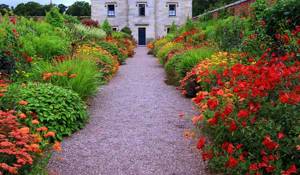
Flower varieties for the summer season
Plants near the house should bloom from May to September, when the first cold snaps begin. Such unpretentious plants as flowers of the bulbous family are very suitable for planting in the country. These flowers are among the very first to bloom in the garden and vegetable garden. But one of the disadvantages is their vulnerability to rodents, which are able to eat bulbs left in the ground for the winter.
What to plant in your dacha from bulbous plants?
Bulbous plants.
- Botanical tulips . They begin to bloom in March and delight with bright colors until the end of May. They are planted for wintering in the fall. It is best to plant the bulbs in special baskets that protect them from rodents. The plant reaches a height of up to 45 cm. The flowerbed with tulips should be on the sunny side of the yard, with not very high humidity. The color range is very diverse . There is no need to dig up these varieties of tulips; they begin to grow on their own by forming new bulbs next to the main planting.
- Another wonderful plant in the courtyard of a summer cottage is iridodictium. Flowering of such a bulbous plant usually begins in April, not earlier. Planting of bulbs should be done from August until the first freezing of the soil in the cold. The place to plant these flowers should be a sunny area of the flowerbed. It is better to mix the soil with sand. The plant does not tolerate excessive moisture . Such flowers look very beautiful in the garden if you group them into groups when planting.
- Crocuses also begin to bloom very early. Depending on the variety, such a plant can bloom in the autumn, but these are very rare varieties. The height of the plant does not exceed 20-25 cm. It is also necessary to protect the crocus bulbs with protective baskets from rodents. It is best to arrange a flower bed near the house in the shade.
- Muscari is an ideal plant for moist soil in the garden. Flowering begins at the end of April at warm outside temperatures and lasts until the end of June, but not all varieties bloom throughout this period of time. The height of the plant does not exceed 30 cm. The flowerbed should be on the sunny side; after the flower has faded, it is better not to water the bulbs abundantly, as this can cause rotting. This is an incomplete list of bulbous plants that begin flowering from the very beginning of the summer season . You can also plant perennial plants on the site that do not require special care. They are planted once in flower beds, after which the emerging sprouts of the plant are tidied up. It is also worth noting that the growth of perennials is very slow. But their beauty after blooming is simply indescribable. As a rule, several varieties of perennial plants are planted in a flowerbed, but so that they do not cover others, and different flowering periods are chosen. In this case, the flowerbed turns out to be dazzlingly beautiful throughout the summer season.
Perennials in the garden
- In the garden you can often find such a beautiful perennial flower as aquilegia. Its flowering begins in mid-May and continues until September. Throughout the summer season, the plant delights with its beauty and variety of colors. It is best to purchase seedlings before planting in a specialized store, because it is not always possible to grow from seeds. The height of the plant reaches 75 cm. It grows wonderfully both in the shade of the garden and in the sun near the house. It is planted during the division of the bush immediately to a permanent place of growth before spring.
- When asked what flowers can be planted in the garden near the house in a flower bed, many gardeners will answer that such a wonderful flower as astilbe will do. There are many varieties of varieties that differ in the colors of the buds and the timing of flowering. Planting is carried out either at the beginning of the summer season or at the end of September. The height of the flower reaches 1.2 m. It grows very strongly, so it needs to be planted in a large flower bed. As soon as this plant begins to bloom, the whole garden will sparkle with bright and magnificent colors. If planting is carried out according to the flowering of one variety after another, then you can admire the astilbe all season long in the country. It is also worth noting that you can plant only one astilbe in a flowerbed and enjoy its beauty. Many people recommend planting astilbe for the winter and covering it with film . It is impossible to say with certainty how correct this is.
- A beautiful garden can also be created by planting a perennial such as doronicum in a flowerbed. Very often this handsome man is also called sunny. It begins its flowering and growth in May and ends in July. Flowerbeds are planted in May and April. The stem can grow to a height of 75-80 cm. Loves humidity and sunny flower beds. Looks very good in the garden along the edges of a flower bed. The early flowering of this perennial looks very beautiful against the background of other growing flower crops. After flowering, you can dig up and plant the bushes in flower beds.
- What flowers should I plant in my dacha from perennial and tall species to create a beautiful flower bed? Of course, a flower like kupena. This plant grows well in areas where shade is located most of the time. Flowering begins in May, when the bulbous crops cease their activity. Planting should be done at the dacha either at the end of April and beginning of May, or in the fall. If you plant the plant in moist soil, then you need to place the flowerbed in a sunny place. The buds are snow-white in the form of capsules, vaguely reminiscent of lilies of the valley.
This is far from a complete series of wonderful perennials for the garden and dacha . Perennials are very practical and not whimsical. It is best to feed them with compost rather than organic fertilizers. They feel great around trees and bushes.
Biennial and annual flowers for the garden
These flowers are grown from seeds. It is very difficult to grow seedlings, so many people prefer to buy not seeds, but a plant that has already been grown to a certain level . This will be much less hassle. But, despite the worries that capricious annual and biennial flowers cause, their beauty never ceases to delight flower growers with their beautiful buds. Therefore, many people prefer seedlings of annual and biennial plants to perennial shrubs.
- Turkish cloves. A wonderful wonderful plant with a beautiful name . To plant this type of flower, you do not need any special manipulations, because it is considered self-sowing. The flowering period can be designated as early summer and September. The height of the plant can reach 50-60 cm, but not higher. The soil requires loosening in the area where flowers are planted so that the flowering is abundant and beautiful.
You can plant it in the shade or the sun, it will not make any difference, any conditions will suit the plant perfectly. This flower is classified as a biennial plant , but the fact is that it is sown on its own, so every year new shoots of this beautiful flower appear. Seeds are formed in flowers after flowering and you should not immediately cut off the fading buds. Allow the seeds to sow, then cut off the buds.
- Phacelia is a beautiful annual flower . It can rarely be found in summer cottages. Flowering begins in June and ends in September. To make Flacelia happy with its flowering, you can sow the seeds throughout the summer season. This is the favorite flower of all insects that collect pollen.
- Wonderful beautiful violas, there are annual and biennial. Many gardeners plant these flowers because of their unpretentious nature. Depending on whether the plant is annual or biennial, flowering begins in different months. But as a rule, these flowers delight with their beautiful inflorescences throughout the summer season. Feels great both in the shade and in the sun.
- Such an annual miracle as pansies begin to be planted as seedlings in early spring. In mid-May, seedlings can be planted in open ground. The flowers are very similar to viola .
- Zinnias differ from many annuals because of their thick trunk. These flowers are extremely resistant to diseases and pests. You can water them once a week. Flowers are perfect for summer residents who come only on weekends. The color range of paints is incredibly diverse; zinnias surprise with all the colors of the rainbow.
How to care for a flowerbed that blooms all summer
A large flower bed requires continuous care. It is necessary to cut off plants that have flowered in a timely manner to prevent self-seeding and self-occupation of territories. At the same time, some seeds may be left for decorative interest. Weeding, tying up stretched plants - all this must be done in a timely manner. Every three years, perennials must be divided to rejuvenate the bushes and create new flower arrangements in the flowerbed.

We have told you the main strategic points that will allow you to create your own beautiful flower bed that blooms all summer long!
carpet flower bed
Flowering or decorative deciduous low-growing plants, most often annuals, are planted in carpet beds. Plants are chosen at the same height. The easiest way to make a carpet flower bed is to plant one type of flower on it. You can create patterns from different types of plants, as in the photo of a flowering flowerbed, and then it will look like a real flowering carpet.

Flower beds made up of plants blooming in different shades of the same color, for example, pale pink, hot pink and purple, look interesting.
Beautiful combinations: pink, blue, white; yellow and blue; red and yellow; blue and orange.
raised flower bed
A raised flower bed is designed on a hill. They build a frame using stones, bricks or other materials and fill it with soil. You can make a low border using timber or boards. It is better to plant annuals in such a flower garden.

Raised flower beds are also arranged in large containers. The main thing is to monitor watering, because the soil in the container will dry out quickly.

